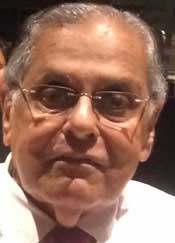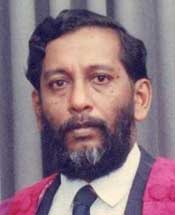Appreciations
View(s):A two-decade long driving force behind the SSC
W.T. Ellawala
 Recently the curtain descended gently on the incredible life of William Tissa Ellawala – Tommy to his friends and family.
Recently the curtain descended gently on the incredible life of William Tissa Ellawala – Tommy to his friends and family.
A third generation Thomian, W.T. Ellawala – recipient of the Victoria Gold Medal and the Mollamure Prize was appointed Head Prefect of S. Thomas’ College Mount Lavinia in his final year at the college. On graduating from the University of Peradeniya with a degree in Economics he worked at the Central Bank of Ceylon before joining the private sector. In a career spanning more than six decades, Tommy was Chairman of several public quoted companies and a highly respected corporate leader.
The writer had the privilege of serving, albeit briefly, on the Executive Committee of the Singhalese Sports Club during the long tenure of Mr. Ellawala as President of the Club. The meetings he chaired were a master class in protocol and procedure. The mild, soft spoken gentleman Tommy, was a stickler for decorum. A steely “gentlemen” was all it took him to restore order at a meeting if it was ever required.
After committee meetings were declared closed, he became “one of the boys” recounting anecdotes from his nearly two decades of office as the Honorary Treasurer of the Club during the Presidencies of Sir John Kotalawela and President J.R. Jayewardene. He was a raconteur par excellence.
Mr. Ellawala’s command of the English language was legendary. “Cognizant” and “countenance” were two words he used that had the writer scurrying for the dictionary when he first heard them. On occasions when there were multitudes of emails being exchanged among Ex-co members on a contentious issue, the President would almost always be the last to respond. His would often be a succinct one-liner articulating his point of view which was accepted without dissent.
Tommy was born privileged, but he was the first to admit that everything he achieved in life had been through his impeccable work ethic and unyielding drive for perfection.
William Tissa Ellawala lived a life that few could aspire to. This immaculately dressed, charismatic gentleman of razor sharp intellect was whisked around in chauffeured limousines right up to his recent demise. His generosity knew no bounds, and his passion was entertaining friends and family which he did regularly, and with great panache.
Mr. Ellawala was revered by the staff of the SSC. The sprawling manicured lawns, the tastefully refurbished restaurants, bars, dining rooms, and the regularly upgraded sports facilities bear testimony to the long hours he spent at the SSC constantly encouraging his team to do their best for the Club and its members.
Tommy Ellawala had it all, but he never lost the common touch.
Wimal Heenetigala
An illustrious but utterly unpretentious and much loved academic
Prof. Lal Tennekoon
 Professor Basis Laliputra Tennekoon, Emeritus Professor of Civil Engineering at the University of Moratuwa was called to rest on March 30, at the age of 82. He was educated at S. Thomas’ College, Mt. Lavinia, where he won the Miller Mathematics Prize in 1960, an achievement that gets one’s name on a board in the college hall. The prize is named after Rev. Edward Miller, the fifth warden of the school, who had read mathematics at Cambridge.
Professor Basis Laliputra Tennekoon, Emeritus Professor of Civil Engineering at the University of Moratuwa was called to rest on March 30, at the age of 82. He was educated at S. Thomas’ College, Mt. Lavinia, where he won the Miller Mathematics Prize in 1960, an achievement that gets one’s name on a board in the college hall. The prize is named after Rev. Edward Miller, the fifth warden of the school, who had read mathematics at Cambridge.
Young Tennekoon fulfilled this early promise, obtaining first class honours in civil engineering from the University of Peradeniya in 1965. There were many Thomians who entered the engineering faculty with him, including Shanthi Kumar Rasaratnam (now holding an MBE for services to water engineering in the UK), Mano Ponniah (who later played first class cricket for Cambridge), and Gerard Rodrigo (subsequently a Marxist development economist).
Prof. Tennekoon went on to complete his PhD at Cambridge University in 1970, on the behaviour of foundations on sandy soils. Other notable Peradeniya graduates/academics who completed PhDs in Cambridge around this time included Alagiah Thurairajah (1962, on shear properties of soils), Munidasa Ranaweera (1969, on the finite element method applied to limit analysis) and Vickramabahu Karunaratne (1970, on plasma physics) – halcyon days for Peradeniya engineering, no doubt. For six years after his PhD, Prof. Tennekoon was attached to the Faculty of Engineering at Peradeniya, teaching at both undergraduate and postgraduate levels.
He joined the Katubedda Campus of the University of Sri Lanka in 1975 and became a Professor of Civil Engineering at the University of Moratuwa in 1984 and Senior Professor in 1994. Moratuwa was fortunate to obtain his services. When I once suggested that his move to Moratuwa was a result of “the best people gravitating to the best places”, his rejoinder was that he would have found it difficult, after he married his wife Preethie, to keep pace with Thurairajah’s work ethic in the Peradeniya soil mechanics lab!
He guided the fortunes of the Civil Engineering Department as its Head from 1980 to 1985, during which time the annual undergraduate intake was increased from 50 to 100, and a new Civil Engineering Complex was constructed to accommodate that increase. He also steered the Faculty of Engineering as its Dean for 10 months in 1994/1995, when there was sharp division in the university regarding the continuation of the NDT programme within the Faculty.
Prof. Tennekoon’s main research interests were based around the problems facing the geotechnical engineers of this country. These were in the areas of: (i) Shallow foundations in low lying areas containing peat and organic clays; (ii) Pile foundations terminating on rock; (iii) Landslides and the stabilisation of slopes; and (iv) Site Investigations for all types of Civil Engineering structures. He also chaired the Moratuwa University’s Senate Research Committee from around 1998 to 2002 and was responsible for setting up the Research Awards Scheme, which contributed significantly to raising research quality at the university.
Over his illustrious career, he provided assistance to many development projects in the country during their planning, design and construction stages, in the collection and interpretation of geotechnical data. Notable contributions have been in (i) the Environmental Improvement Project for the city of Colombo; (ii) the Southern Highway Project from Colombo to Matara; (iii) the Beira Lake Restoration Project; and (iv) several multi-storeyed building projects such as Ceylinco Celestial Towers, Crescat Towers, HNB Tower, Bank of Ceylon Tower, Central Bank Tower and Havelock City Project. He worked closely with Geotech (Pvt) Ltd, where his close friend Eng. Parakrama Jayasinghe was Managing Director. At times he enlisted the services of his colleagues, most of them his juniors. The consideration paid by this senior engineer to the disciplinary competencies of his younger associates only served to increase our own reciprocal respect for him.
Prof. Tennekoon served as the principal author for the development of two standards for the Institute of Construction Training and Development (ICTAD), in which his research findings were also incorporated. The two standards were in the areas of ‘Site Investigation’, and ‘Pile foundations end bearing on rock’; and were published by the Sri Lanka Standards Institution (SLSI).
He was a Founder Member of the Sri Lanka Geotechnical Society (SLGS) in 1987; and held its Presidency from 1994 to 2000. He was recognised for his contributions to the Geotechnical Engineering profession in Sri Lanka by the SLGS at an International Conference organised by the Society in 2007. The Institution of Engineers Sri Lanka bestowed on him an Award for Excellence in 2008. He was elected a Fellow of the National Academy of Sciences of Sri Lanka in 2013.
In April 2003, Prof. Tennekoon was invited by the Government of Sri Lanka to be part of a team for implementing the World Bank funded project for the Improvement of Relevance and Quality of Undergraduate Education (IRQUE). This was a six-year project where the major component was the establishment of a Quality Enhancement Fund (QEF). This was to be a strategy in which quality and relevance were to be improved through the entire university system by the implementation of a competitive funding scheme. He was responsible for the implementation of the QEF component, which often involved choosing between competing study programmes. His dispassionate judgment and clinical impartiality ensured the smooth operation of this project; it also endeared him to virtually the entire university community in Sri Lanka. Some of us wondered whether he was deserting his primary calling to engineering through this involvement, but he was only broadening his horizons.
He later became passionate about outcome based engineering education, and chaired the Accreditation Board of the Institution of Engineers, Sri Lanka, responsible for accrediting engineering programmes under the Washington Accord.
Twenty eight years ago, Lal Tennekoon suffered a massive heart attack and was in the intensive care unit for many days. His loving wife Preethie and his children Layanthi and Banuka rarely left the hospital premises, at times camping out on its staircases, as I recall. Theirs was clearly a very loving family. How fortunate that we all got him back from the brink of death. From a private communication he circulated to some of us soon after, I am aware that he was extremely grateful to all who attended on, ministered to and prayed for him. He himself looked after his wife caringly, eschewing all professional and other engagements, towards the end of her life. Preethie’s demise hastened his own.
Prof. Tennekoon was an illustrious but utterly unpretentious and much loved academic; a greatly sought after and highly respected geotechnical consultant; and a passionate advocate for outcome based engineering education. His twin concerns for practice oriented research on the one hand and engineering education on the other, continue to be nurtured by those he engaged with.
His geotechnical expertise endures in the careers of his one-time students, all now emeritus or full professors themselves – Professor Anuruddha Puswewala (rock mechanics); Professor Athula Kulathilake (slope stability); Professor Saman Thilakasiri (piled foundations); Professor Udeni Nawagamuwa (environmental geotechnics); and Professor Nalin de Silva (shallow foundations).
Prof. Priyan Dias
Simplicity was his motto
Godwin Walter Samarajiwa
Godwin Walter Samarajiwa was born on December 14, 1928 at ‘Samaragiri’ Panadura to Percy Samarajiwa and his wife Grace Ethel. He had five siblings.
An old Johnian, he joined the Bank of Ceylon in 1947 when he was in his late teens. Well known for being extra methodical, his colleagues would fear to take even a pen from his table because they had to replace it in the exact position. At home, my mother used to get pulled up for taking his pens.
As a teenager, he was crazy over bicycles and in his early employment used to be the proud owner of several motor bikes. He visited Haputale every year. I remember the old photos of my father posing with his bike, looking quite handsome and well attired.
He later took a fancy to cars. He was famous in Panadura for his blue Morris Minor adorned with a row of badges on the front buffer and sarcastic stickers in the interior. Whoever slammed the door of his car did not get a second chance for a lift. He was so careful with all his possessions. As children, my brother and I enjoyed being driven to school and other outings.
A God-fearing person, he had much faith. He believed in faith healing and did not wish to take medicine unless as a last resort. His faith helped him manifest all his dreams. In turn, he was thoughtful of the needy and did not hesitate to help people.
An animal lover he was a longstanding member of the Wild Life Association of Sri Lanka. He loved his pets and had many through his life. He was also a marksman and used to enjoy target practice even at a ripe old age, scaring off thieves in the back garden.
Simplicity was his motto. He always wanted to live a simple life and preferred to build his estate for his heirs. Completing a full life of 96 years, he was able to celebrate their 65th wedding anniversary in a modest way at ‘Samaragiri’. He so wished to breathe his last breath at ‘Samaragiri’. He passed away on January 16, 2025 in the same room where he was born.
Thathi, we love you and think of you always. May your soul rest in peace.
Krishanie Samarajiwa
You made a silent voice heard across SriLanka
Gamini Jayawickrema Perera
The mushrooming “Hela Bojun” stalls today by the government and private sectors is a direct result of a daring decision taken by the Chief Minister of the North Western Province in 1983.
Gamini Jayawickrema Perera whose first death anniversary falls this year, was the first policymaker to establish a state sponsored sales outlet for grassroot level women entrepreneurs of the food crop sector. It was a mammoth task, to absorb traditionally home-bound unemployed women into the food chain and to transform them into sustainable, profitable income earners. It required meticulous planning and methodical execution of the plans.
The Chief Minister capitalised on his position and power to capture the available agricultural expertise in his province to make his dream a reality. His vision for the needy women was materialised by the officers of the Department of Agriculture of the NWP. A knowledgeable team of agriculture experts was formed under his exceptional leadership. A transparent constitution was formulated by the team to ensure a justifiable selection of the marginalised women to address their pressing financial needs. The team drew out the hidden powers of women by training them on appropriate technical knowhow, communication skills, book keeping, saving and investment procedures and to deal with the changing demands of the customers successfully.
The Chief Minister extended his further assistance to the trainees to sweep all the obstacles out of the way to come to the forefront as agro-based entrepreneurs of the food crop sector.
The beauty of his wisdom did not end there. He inspired the trainers to equip the potential entrepreneurs with technology to utilise the available raw materials at hand for marketable products.
This led the entrepreneurs to adopt methods of preservation techniques during glut periods in minimising wastage of crop harvest and for higher profits during lean periods of the crops. This strategy also helped the women balance their time and energy and their roles at home, community and with the enterprise.
Sir, your vision and strategy implemented in 1983 convinced our society of the valuable contribution of rural farming women in the food chain.
The sales outlet you opened for farm women in the Kurunegala district in 1983 named by the Department of Agriculture as “Poshana Sala” (nutrition stall) would have been a little drop in your wide spectrum of ministerial activities. Now it has evolved to be a mighty ocean empowering women in the food crop sector socially and economically island-wide mostly under the unique name “Hela Bojun”.
May you attain blissful Nirvana.
R.R.S.
Searching for an ideal partner? Find your soul mate on Hitad.lk, Sri Lanka's favourite marriage proposals page. With Hitad.lk matrimonial advertisements you have access to thousands of ads from potential suitors who are looking for someone just like you.


